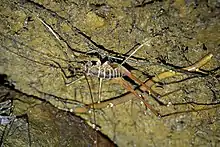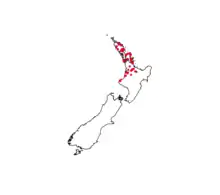| Auckland cave wētā | |
|---|---|
 | |
| An Auckland cave wētā (Pachyrhamma acanthoceras), found in Titirangi, Auckland, New Zealand. | |
| Scientific classification | |
| Domain: | Eukaryota |
| Kingdom: | Animalia |
| Phylum: | Arthropoda |
| Class: | Insecta |
| Order: | Orthoptera |
| Suborder: | Ensifera |
| Family: | Rhaphidophoridae |
| Genus: | Pachyrhamma |
| Species: | P. acanthoceras |
| Binomial name | |
| Pachyrhamma acanthoceras (Milligan, 1926) | |
 | |
| Observations of Pachyrhamma acanthoceras from iNaturalist (as of September, 2021). | |
| Synonyms | |
| |
Pachyrhamma acanthoceras,[1] also known as the Auckland cave wētā, is a large species of cave wētā endemic to New Zealand.[2]
It is distributed in the upper North Island, from Northland to Taranaki. This species is known to be present in old water-works tunnels in the Waitākere Ranges,[1] west of Auckland.[2]
Large groups of individuals can be found in the tunnels,[2] but there is no known social life.[3] These wētā are flightless and nocturnal.[4]
Description
Auckland cave wētā bodies are 3.5 centimetres in length. They have long hind legs and antennae, making their total length 25 centimetres.[2]
Auckland cave wētā can be sexed due to sexually dimorphic body forms. The adult female is distinguished from the male by having a slightly curved, scimitar-like ovipositor that extends from the rare of her abdomen[3] and is almost as long as her body.[2] She lays eggs into the soil of the cave wall. Females have larger, stockier bodies, while males can be distinguished by long hind-legs,[5] which suggests they might have the role of searchers in scramble-mate competition.[6]
Both sexes have long filiform antennae between 150-200mm in length, which consist of over 500 flagellomeres (antennal segments) in total.
Males have large spines (fused setae) on their antennae, found on both the dorsal and ventral sides.[1][5] Sensilla are sexually dimorphic, with females having longer sensilla than males.[5]
They are a chocolate-brown colour with paler back edges to their segments. This gives them a banded appearance.[2]
Distribution and habitat
Cave wētā are often found in groups around or in the entrances of caves, behind projecting rocks or within crevices. Typically, younger individuals are found closer to the entrance than more mature individuals.[7]
Diet
Foraging behaviour occurs after dark when wētā leave crevices they occupy during the day.[4]
Cave wētā are characterised as scavengers. Other insects, fungi, bryophytes and angiosperms are all known food sources of cave wētā. Cannibalism is also known to occur within cave wētā species, with most vulnerable times being during the mating season and post-moult.[7]
Taxonomy
Pachyrhamma acanthoceras are closely related to P. waipuense and P. waitomoense, and they could be treated as a single species.[1]
Cook et al. (2010) follows W.F. Kirby (1906) and Karny (1937) in treating Pachyrhamma as a neuter noun, and thus use a neuter suffix for the species name, i.e. acanthoceras rather than acanthocera.[1]
References
- 1 2 3 4 5 Cook, Lorraine D.; Trewick, Steven A.; Morgan-Richards, Mary; Johns, Peter M. (2010). "Status of the New Zealand cave weta (Rhaphidophoridae) genera Pachyrhamma, Gymnoplectron and Turbottoplectron". Invertebrate Systematics. 24 (2): 131. doi:10.1071/IS09047. ISSN 1445-5226.
- 1 2 3 4 5 6 Early, John (2009). Know your New Zealand ... native insects & spiders. New Holland. p. 64. ISBN 9781869662530.
- 1 2 Richards, Aola M. (1961). "Some observations on New Zealand cave-wetas". Tuatara. 9 (2): 80–83. Retrieved 9 September 2017.
- 1 2 Fitness, Josephine (2016). Te pūtaiao o tokoriro : taxonomy and diversity of New Zealand cave wētā (Orthoptera; Rhaphidophoridae) : a thesis presented in fulfillment of the requirements for the degree of Doctor of Philosophy in Zoology at Massey University, Manawatū, New Zealand (Thesis thesis). Massey University.
- 1 2 3 Fea, Murray P.; Mark, Cassandra J.; Holwell, Gregory I. (2018). "Sexually dimorphic antennal structures of New Zealand Cave Wētā (Orthoptera: Rhaphidophoridae)". New Zealand Journal of Zoology. 46 (2): 124–148. doi:10.1080/03014223.2018.1520266. ISSN 0301-4223. S2CID 91313050.
- ↑ Kelly, Clint D.; Bussière, Luc F.; Gwynne, Darryl T. (2008). "Sexual Selection for Male Mobility in a Giant Insect with Female‐Biased Size Dimorphism". The American Naturalist. 172 (3): 417–423. doi:10.1086/589894. hdl:1893/914. ISSN 0003-0147. PMID 18651830. S2CID 22494505.
- 1 2 "Some Observations on New Zealand Cave-Wetas | NZETC". nzetc.victoria.ac.nz. Retrieved 10 September 2021.